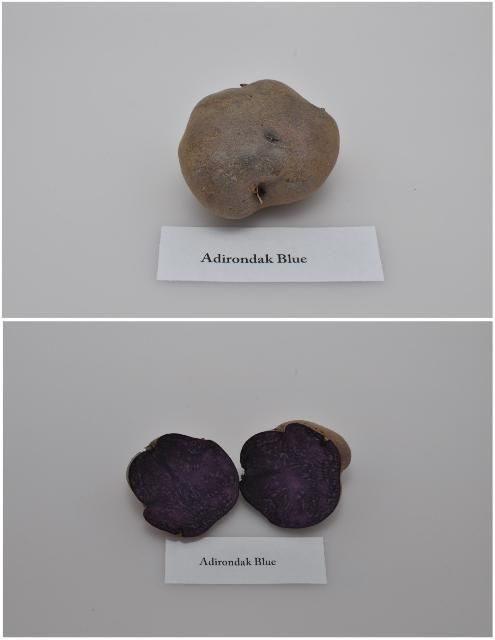There are several potato varieties available in the market today. Most of them have been bred or developed in production regions other than Florida. The University of Florida Potato Variety Evaluation Program screens new germplasm from public and private breeding programs and identifies the most promising cultivars for commercial potential considering broad adaptability to Florida climate and conditions and market purpose: processing, fresh-market and specialty-type varieties. Over the years, the UF/IFAS Potato Variety Program has become an important reference to vegetable growers, seed producers, processors, crop insurance agencies, and brokers looking for alternative potato varieties to explore different markets, improved characteristics, and yield. This UF/Potato Variety Trials Spotlight presents a summary of the field evaluation of tuber yield and quality performance of the potato variety 'Adirondack Blue' cultivated in Florida.
General Comments
'Adirondack Blue' is a potato variety commonly grown for the specialty potato market. It was selected from progeny of a cross between N40-1 and NY96 and tested under the pedigree S45-5 by Robert Plaisted, Ken Paddock, and Walter De Jong at Cornell University. It was released by the New York State College of Agriculture and Life Sciences at Cornell University in 2003. Tuber production and quality results provided in this spotlight are summarized from variety trials conducted at the UF/IFAS Hastings Agricultural Extension Center from 2011 to 2019.
General Characteristics
'Adirondack Blue' tubers have purple and slightly netted skin with a purple flesh (Figure 1). The tubers are mostly oblong with a fair to good appearance and intermediate eye depth, according to Florida's rating codes for potato tuber characteristics (Tables 1 and 3). The variety has short dormancy (time required for sprout emergence) with a low tuber specific gravity under Florida growing conditions, 1.058 on average (Table 2). The variety demonstrated similar marketable yields and good tuber characteristics compared to the commercial standard 'Red LaSoda' (Table 2). On average, 68% of the tubers produced were from the tuber size distribution classes A1 to A3.

Credit: Lincoln Zotarelli, UF/IFAS
'Adirondack Blue' exhibits slight susceptibility to hollow heart and no susceptibility to internal heat necrosis, corky ring spot, or brown rot under Florida conditions (Table 3). This variety is moderately susceptible to silver scurf (Helminthosporium solani), common scab (Streptomyces scabies), golden nematode (Globodera rostochiensis Ro1), pink rot (Phytophthora erythroseptica), leafhopper (Empoasca fabae), Colorado potato beetles [Leptinotarsa decemlineata (Say)], and potato virus Y. It is highly susceptible to Fusarium dry rot (Fusarum spp.). 'Adirondack Blue' is highly resistant to foliar late blight (Phytophthora infestans strain US-23). The standard UF/IFAS Extension recommended disease and weed control program described under Potato Production (Chapter 14 of the Vegetable Production Handbook for Florida, https://edis.ifas.ufl.edu/cv131) should be followed.
Season Length and Growth
'Adirondack Blue' is a midseason-maturing variety under Florida growing conditions. Season length was on average 87 days from planting to harvest, depending on growing conditions during the season. Tubers should be harvested two weeks after vine kill to improve tuber maturation and skin set. Potatoes with proper skin set maintain better skin color, lose less weight in storage, and are more resistant to bruising and soft rot. For more information about vine killing on potatoes, see Potato Vine Killing or Desiccation described in (Zotarelli et al. 2016). Late in the season, tuber size should be checked regularly in order to harvest tubers with desirable marketable size. Soil moisture should be managed late in the season to avoid high soil moisture conditions that cause enlarged lenticels and delayed skin set.
Fertilization
UF/IFAS trial plots are normally fertilized with 200 to 230 lb/ac of N. The first application of 100 lb/ac of N (granular) is typically incorporated in the bed prior to planting, followed by one or two side-dress fertilizer applications at emergence and/or at tuber initiation. Phosphorus and potassium application follow the UF/IFAS guidelines described in Liu et al. (2020) and normally range between 45 to 100 lb/ac of P2O5 and 170 to 235 lb/ac of K2O.
Planting
A seed piece of 2.5 to 3 oz is recommended for planting. The crop should be planted with 40 inches between rows and 8 inches between plants, at 3 to 4 inches deep. A seed rate of 2,000 to 3,000 lb/acre of seed is expected.
Other Information
For additional information on cultivation and weed and disease management, see the Potato Production chapter of the Vegetable Production Handbook, available at http://edis. ifas.ufl.edu/cv131.
References
Hutchinson, C. M., J. M. White, D. M. Gergela, P. A. Solano, K. G. Haynes, R. Wenrich, and C. S. Lippi. 2003. "Performance of chip processing potato varieties in northeastern Florida." HortTechnology 13 (4): 706–711. https://doi.org/10.21273/HORTTECH.13.4.0706
Liu, G., E. H. Simonne, K. T. Morgan, G. J. Hochmuth, S. Agehara, and R. Mylavarapu. 2020. Chapter 2. Fertilizer Management for Vegetable Production in Florida. Vegetable Production Handbook for Florida, 2020–2021 Edition. CV296. Gainesville: University of Florida Institute of Food and Agricultural Sciences. https://edis.ifas.ufl.edu/cv296
New York State College of Agriculture and Life Sciences. 2003. "Adirondack Blue." https://potatoes.ncsu.edu/NE1014reports/Adirondack_Blue.pdf. Accessed February 2, 2021.
Sisson, J. A., and G. A. Porter. 2002. "Performance evaluations of potato clones and varieties in the northeastern states—1999." Maine Agr. For. Expt. Sta., Misc. Publ. 751.
Zotarelli, L., S. Sargent, P. Dittmar, and M. Makani. 2016. Potato Vine Killing or Desiccation. HS181. Gainesville: University of Florida Institute of Food and Agricultural Sciences. https://edis.ifas.ufl.edu/hs181
Wikipedia. 2017. "Adirondack Blue." https://en.wikipedia. org/wiki/Adirondack_Blue_potato. Accessed February 2, 2021.
Zotarelli, L., P. J. Dittmar, P. D. Roberts, J. Desaeger, and B. Wells. 2020. Chapter 14. Potato Production. Vegetable Production Handbook for Florida, 2020–2021 Edition. HS733. Gainesville: University of Florida Institute of Food and Agricultural Sciences. Agricultural Sciences. https://edis.ifas.ufl.edu/cv131
Summary of production statistics and specific gravity of 'Adirondack Blue', a fresh-market potato variety grown at the UF/IFAS Hastings Agricultural Extension Center, Hastings, FL from 2011 to 2016, excluding 2013.